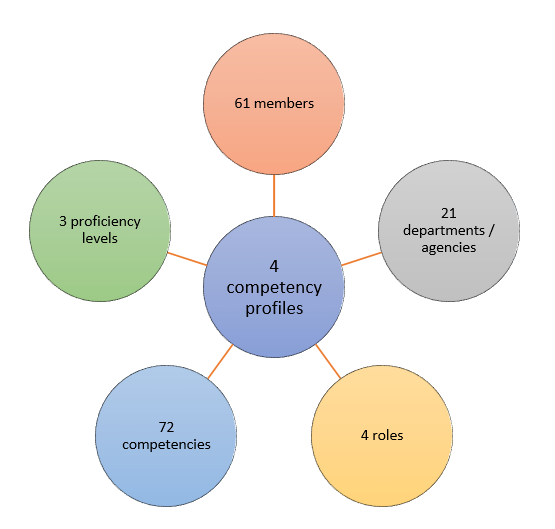Developing Competency Profiles to Shape Data Science in the Public Service
By: Reginald Maltais, Statistics Canada
Introduction
One of the early issues identified by the Data Science Network (DSN) when it was first formed, was the difficulty attracting and retaining data science talent across the Government of Canada (GC). There were no common instruments used to equally assess candidates across government, nor was there a way to determine the skills required for career growth for data scientists already in the government.
Competency profiles provide a way to document the minimum level of skill required across various disciplines for any given position within the federal government. In April 2021, the DSN formed the Data Science Competencies Working Group (WG) to identify (1) what roles data scientists could fill across the GC, and to determine (2) the competencies required for those roles.
The WG began with a workshop at the 2021 Data Conference, where they decided to focus on the following data science positions:
- Data Science Analyst
- Data Science Engineer
- Data Science Visualization Specialist
- Data Science Manager
Figure 1: Competency profile hub and spoke model

Figure 1: Competency profile hub and spoke model
A hub and spoke image depicting the four competency profiles (the hub) and the surrounding five spokes that contributed to its development. This includes the combined effort of 61 members of the WG from 21 departments and agencies. Together, they defined 72 different competencies at three levels of proficiency for each role, allowing for flexible staffing and providing a clear development path for those wishing to increase their data science skills in the GC.The case for competency profiles
Competency profiles are not the type of human resources (HR) instrument people immediately think of when trying to create a job posting or apply for a position. Given that roles are usually defined by their job descriptions, and in government, the Statement of Merit Criteria (SoMC) is used to list a position’s qualifications for hiring purposes, what value can a competency profile bring?
Competency profiles fill a large gap that can be used by people of all levels for multiple reasons –managers can use the competency profiles to develop job descriptions to post a position to the GC Jobs bank. HR specialists can also use competencies to write position-specific SoMCs, allowing job posters to be created for varying levels of expertise while ensuring a level of consistency across the government. Competency profiles also have the added benefit of not being tied to a particular classification or level, unlike job descriptions.
For example, a policy analyst who is interested in becoming a data science analyst could use a competency profile to learn which skills are required to fill that role. They can then integrate them into their learning plan of their current position. This can help them leverage the data they currently work with and guide them as they develop the proficiencies required to become a data science analyst.
Technology talent is scarce; significant internal competition exists for scarce talent who are not always staffed on priority initiatives
Not being tied to an existing classification or level provides maximum career flexibility and allowed the WG to really consider what it means to be a data scientist in the GC without being limited to what is defined in existing frameworks. Of course when someone is hired into a position, it needs to be classified appropriately, which is why the competency profiles are being used as input to the Information and Data Functions Human Resources Working Group. This group aims to standardize job descriptions, develop a story that shows how a career progresses, and to help foster visibility of cross-governmental availability of talent.
How to use them today
The GC fills all kinds of positions that work with and analyze data. Not everyone wants or needs to be a data scientist, but providing a means for employees to build a plan that increases their analytical proficiencies and improve the diversity of skills will help strengthen the GC as a whole.
Researchers who want to incorporate data science into their workflows don’t necessarily want to give up their research positions. These profiles help them identify the proficiencies required to ensure high quality data science can be incorporated into their work. Managers looking to build robust teams can combine the profiles with the GC Data Competency Framework from the People and Culture Working Group under the GC Enterprise Data Community of Practice to create teams that cover a wide range of skills and are ready to address the needs of their departments.
Supporting diverse team structures
There are multiple angles to data science, which means there are multiple ways to integrate data science into teams. Some organizations have enough need that they’ve formed entire divisions to provide data science expertise as a service, while others are trying to embed data scientists into new or existing business lines. Each approach introduces its own challenges in recruiting, retention, and career progression.
The competencies that were developed provide some insight into individuals and organizations on the minimum level of proficiency for different levels. This way, hiring managers can target the skills and proficiency of the position being filled, and it allows candidates to see what the skill progression required to move to a more senior data science role.
Foundation for an improved HR value chain
Talent management is a complex topic. As seen in the Common Human Resource Business Process, competency profiles are one part of a larger picture. By leveraging the competencies developed by the community, hiring managers are now collaborating on the development of interdepartmental standardized job descriptions under the Information and Data Functions Human Resources Working Group. This will apply the competencies to specific classifications in the GC, further advancing reusable components that will make hiring easier.
There is no shortage of resources to advance your technical abilities as a data scientist. The Data Science Network for the Federal Public Service highlights learning opportunities regularly. But technical ability isn’t the whole story of a public servant, and these competencies provide a framework people can use to help round out their learning plan. From highlighting the importance of ethics and privacy protection to storytelling, the competencies provide data scientists ideas on where they can further improve their abilities, and provides a reference when trying to develop a learning plan.
A bright future is predicted
Data science is still relatively new in the public service. While it is present in many aspects of Canadians lives already, the ability to leverage data science to better serve Canadians is only getting started. From Comparing Optical Character Recognition Tools for Text-Dense Documents vs. Scene Text, to improving service times by automating data ingestion from written document (see Document Intelligence), to supporting data-driven and Responsible Use of Automated Decision Systems in the Federal Government, data science is already being applied to great effect. The government provides a lot of services, with the potential to apply data science in many different ways. Analysts already working in those services now have an additional resource for how they can improve their own skills to introduce data science, and managers have new tools they can use to assess data scientists when trying to integrate them into their program areas. Visit the Data Science Network for the Federal Public Service's GCWiki page to view the competency profiles for the following positions:

If you have any questions about this article or would like to discuss this further, we invite you to our new Meet the Data Scientist presentation series where the author will be presenting this topic to DSN readers and members.
Wednesday, September 14
2:00 to 3:00 p.m. EDT
MS Teams – link will be provided to the registrants by email
Register for the Data Science Network's Meet the Data Scientist Presentation. We hope to see you there!
- Date modified: